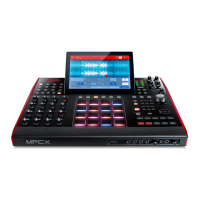16
Basic Concepts
This chapter should help explain some fundamental aspects of MPC X.
The MPC workflow is quite different from traditional digital audio workstations (DAWs). In most typical DAWs, each
track uses an instance of each instrument, and all tracks are always playing even if they don’t contain any audio or
MIDI information. Furthermore, your entire project needs to be arranged just as the resulting song would be.
This isn’t the case with MPC X, which offers much more flexibility within your project. It’s important to understand
some basic terms, though:
A sequence is a “building block” of a song. It contains multiple tracks that play at the same time like a normal
DAW. In a project, you might create one sequence for your verse and another sequence for your chorus,
alternating and/or repeating each one in a specific order to create the song. (A project can contain 128 sequences.)
A track is a layer in a sequence. There are two types of tracks:
MIDI tracks consist of MIDI data only, no audio data. These tracks produce sound by using programs,
described below. Unlike a normal DAW, each MIDI track exists only in its sequence. The advantage of this is
not having to manage empty or unwanted tracks across all of your sequences—each sequence contains only
the tracks you want to use in it. If you want to use the same track across multiple sequences, you can copy
the track from one sequence into another. (A sequence on MPC X can contain 128 MIDI tracks.)
Audio tracks consist of a recorded audio signal, like a traditional DAW. These tracks do not use programs because
the audio is already contained in the track. Also, unlike MIDI tracks, audio tracks are present in every sequence in
the project, even if the tracks themselves are empty. (A sequence on MPC X can contain 8 audio tracks.)
A program is a preset through which MIDI tracks are routed. Programs may contain audio samples that are
triggered when tracks plays through them, producing the sound you want on that track. Programs are
independent of tracks and sequences, so you can set multiple tracks to use the same program (unlike normal
DAWs where each track requires its own set of samples). Furthermore, you can use the same program/programs
across multiple sequences. (A project can contain 128 programs.)
Each program can be played using the 16 pads (across eight pad banks, which gives you access to 128 pads in
each program). Each pad plays a MIDI note when you press it, but that MIDI note will trigger something different
for each program. For instance, in drum programs, the pads are assigned to samples—one pad could trigger a
kick drum sound and another could trigger a snare drum sound—whereas in keygroup programs, each pad
triggers a MIDI note that plays the corresponding pitch of the assigned to its keygroup.
Here’s a diagram to illustrate an example of how these pieces could work together:
Please take a look at the following Tutorial chapter, as well. It will walk you through the creation of a short song to
show you some of the MPC software’s most important features.
Mixing
Sequence
Track (MIDI: Drums)
Track (MIDI: Bass)
Track (MIDI: Keys 1)
Track (MIDI: Keys 2)
Track (MIDI: Synth)
Track (Audio: Vocals)
Track (Audio: Vocals)
Track (Audio: Guitar)
Drum Program
(Drums)
Keygroup Program
(Bass)
Keygroup Program
(Keys)
Keygroup Program
(Synth Lead)

